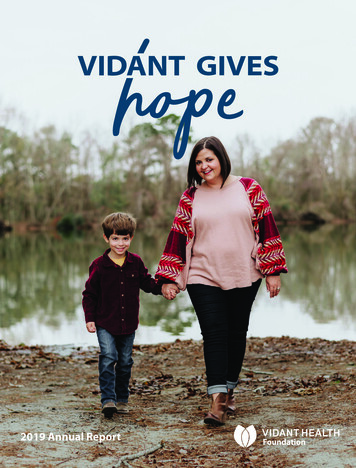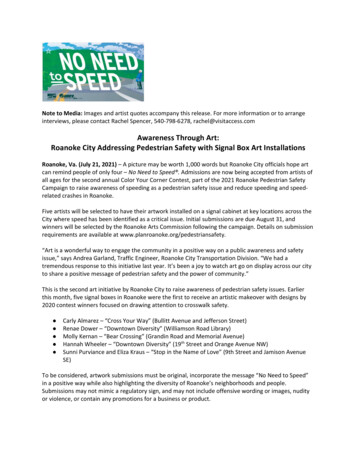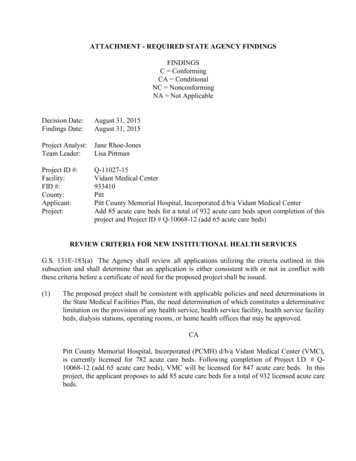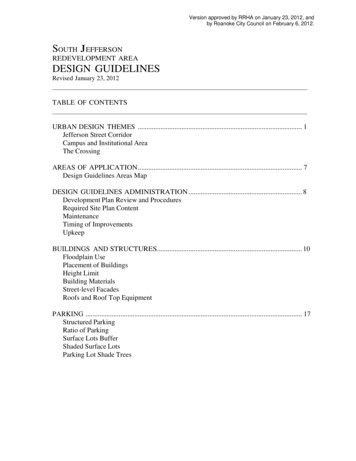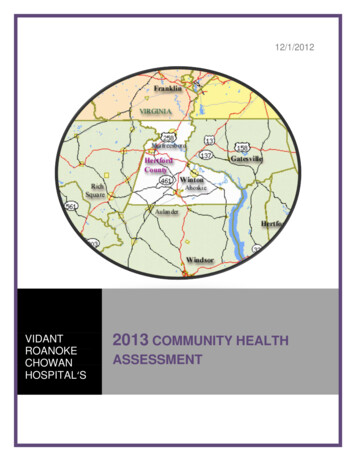
Transcription
12/1/2012VIDANTROANOKECHOWANHOSPITAL‘S2013 COMMUNITY HEALTHASSESSMENT
Recognition of Authors and ParticipationCommunity Health Assessment information compiled by staff of theHertford County Public Health Authority:1. Barbara Earley, RN, MSNDirector of Health Planning and Resource DevelopmentMSN specializing in Community Health Nursing Leadership2. Crystal Dempsey, CHESHCPHA Health Promotion and Marketing coordinatorBS in Community Health Education3. Nikki Moore, CHESPast HCPHA Health Promotion and Marketing coordinatorBS in Community Health Education4. James Madson, RN, MPHHertford County Public Health DirectorMPH in Biostatistics and EpidemiologyWith Special Thanks and Partnership with Vidant Roanoke Chowan HospitalAnd Special Acknowledgment of Substantial Participation in theMAPP/Community Health Assessment ProcessRoanoke Chowan Community HealthCenter Hertford County CooperativeExtension Hertford County Pregnancy CareCenter2
Executive SummaryThe Community Health Assessment (CHA) for Hertford County is due to the NCDivision of Public Health on December 1, 2012. Hertford County Public HealthAuthority (HCPHA) is responsible for conducting the CHA every four years. Our lastCHA was submitted in 2007 but because we agreed to participate in a NACCHO CHAmodel pilot, we were granted permission from the state to extend our deadline to 2012.We worked with Vidant Roanoke-Chowan Hospital to integrate their communityassessment into this document as a single source evaluation.According to the National Association of County and City Health Officers (NACCHO),A community health assessment is a process that uses quantitative andqualitative methods to systematically collect and analyze data to understandhealth within a specific community. An ideal assessment includes informationon risk factors, quality of life, mortality, morbidity, community assets, forcesof change, social determinants of health and health inequity, and informationon how well the public health system provides essential services. Communityhealth assessment data inform community decision-making, the prioritization ofhealth problems, and the development, implementation, and evaluation ofcommunity health improvement plans.The CHA model that the HCPHA agreed to pilot is a community wide strategic planningframework for improving public health known as MAPP, which stands for Mobilizing forAction through Planning and Partnerships. The model provides the framework forconvening a variety of organizations, groups and individuals that comprise the localpublic health system. Many of the previous Hertford County Healthy Carolinianmembers and current Hertford County health care organizations are involved in theHertford Health Maintenance Alliance (HHMA), a Care Share Alliance organization. TheHHMA members participated on the MAPP process. The HHMA team will adoptimplementation strategies to address the most significant health issues selected duringthe community health assessment process: 1) Access to Care 2) Adolescent Health 3)Chronic Disease Prevention 4) Social Determinants of Health.Due to decreased health promotion funding in the state, HCPHA lost the initial MAPPcoordinator in 2011 and the replacement coordinator in August 2011. The CurrentHealth Promotion Coordinator and Health Planning Director have completed theprocess detailing the six MAPP phases and results, and expanded the demographicsand health statistics beyond the MAPP model requirements. An epidemiologistreviewed the health statistics and helped to analyze the findings.HCPHA hopes that this summary will guide the HHMA and other organizationsinterested in implementing strategies to address our most significant health issues.3
IntroductionDid you know that in Hertford County:394 people were treated for STD at HCPHA in 2011?49% of the Hertford County residents are low income? ( 44,628 or less annually for afamily of four in 2010)?Over 25% of the Hertford County residents do not have health insurance?24% are food insecure which means they lack of access some of the time to enoughnutritionally adequate foods)?Parenthood is the primary reason for teen girls to drop out of school?70% of pregnancies were unplanned?Some 24,433 people live, work and play in Hertford County North Carolina. The facts statedabove regarding the health of the people in Hertford County suggest that we currently facesignificant health challenges. We know that these concerns as well as new health ones willcontinue to challenge our county, state and nation in the years ahead.The North Carolina Division of Public Health mandates that the county provide certain healthservices (e.g. disease surveillance, immunizations, family planning, environmental health, etc.),which Hertford County does through its Public Health Authority. These services, however,represent only a small portion of the resources that contribute to the health of our community.The majority of our community's health services are provided by a network of private and nonprofit organizations, in addition to government organizations in our county, region and thenation. This expansive network of service providers comprises the Hertford County PublicHealth CHHHMAParks andRecreationAhoskiePregnancy HomeRC FoundationCivic OrganizationsFaith BasedOrganizationsHCPHASchoolsElected iversityECBHPharmaciesFireHealth Care ProvidersNursing Home andAssisted Living4
Table of ContentsExecutive Summary .3Introduction .4Purpose of Community Health Assessment .7Geographic Location of Hertford County .7History of Hertford County .8History of Hertford County Public Health Authority .9Community Assessment/MAPP Team .13Vision of Community Health Assessment .14Developing common values: .16Four Assessments .171.Community Health Status Assessment .172.Community Themes and Strengths Assessment (Community Survey) .173.Local Public Health Systems Assessment.184.Forces of Change Assessment (Environmental Scan).19County Demographics .20Social Determinants of Health Related Data . 22Housing .22Transportation .23Education .23Access to Care .23Hope.24Income .24Environmental Factors.25Water quality.25Air quality.25Physical Environment .262012 Physical Environment Peer County Comparisons.26County Ranking Snapshot .27Leading Causes of Death .28Trends and Peer County Comparisons .29Breast Cancer .305
Prostate Cancer .31Colon/Rectum Cancer .32Peer County Cancer Comparison .33Heart Disease Mortality .34Stroke Mortality .35Peer County Stroke Mortality Comparison .35Diabetes Mortality .36HIV/AIDS Disease .37Teen Pregnancy .38Peer County Teen Pregnancy Comparison.38Infant Mortality .39Peer County Infant Mortality Comparisons.39Crime and Violence .40Motor Vehicular Accidents .40Communicable Disease Data .41Hospital Data .42Vidant Roanoke Chowan Hospital top Diagnosis .42Vidant Roanoke Chowan Hospital 30 Day Re-Admission Rate .42Vidant Roanoke Chowan Hospital In-patient Admissions .43Vidant Roanoke Chowan Hospital Out-patient Encounters .44Vidant Roanoke Chowan Hospital Emergency Department Visits .44Health Care Resources .45Prioritization Activity and Results .49Next Steps .50Appendices .50A. Community Survey Results .50B. Local Public Health System Assessment .50C. Forces of Change Assessment.506
Purpose of Community Health AssessmentThe community health assessment is the foundation for improving and promoting the health ofpeople in Hertford County. The role of the community health assessment is to identify factorsthat affect the health of our population and determine the availability of resources within thecounty to address these factors. Through collaborative efforts forged among community leadersour public health agencies, healthcare related agencies, academic centers, businesses andresidents can begin to answer what are the strengths in our community, what health concernsresidents have, what are the emerging health issues and what resources are needed.The community health assessment is the first step in a four year community health planningprocess. The second step involves the creation of community action plans to address the mostsignificant health issues revealed during the community health assessment. The third andfourth steps included implementation, reassessment and evaluation of the community actionplans.Geographic Location of Hertford CountyHertford County is a rural agriculture county located in the Northeastern coastal plains of NorthCarolina. It is bordered on the North by Virginia, on the east by Gates County and ChowanCounty, on the South by Bertie County and on the east by Northampton County. The Chowanriver is the boundary between Hertford County and Gates and Chowan Counties.7
History of Hertford CountyThe soil and natural water resources of Herford County sustained its early inhabitants. Threeseparate tribes called modern-day Hertford County home; the Tuscarora, Chowanoac andMeherrin all lived in the region. The Meherrin Tribe of Hertford County is recognized by thestate, with more than 700 of the 900 tribal members residing around Winton near the MeherrinRiver. The first non-indigenous settlers came from Southside Virginia to take advantage of themore productive soil.Hertford County was formed in 1759 from Chowan, Bertie and Northampton counties and wasnamed in honor of Francis Seymour Conway, Earl of Hertford. The Chowan River serves as aboundary between Hertford and Gates Counties. The first court was held at Cotton's Ferry butnearby Winton, originally Wynntown, was incorporated in 1766 and replaced Cotton's Ferry asthe county seat. The town's location on the Chowan River resulted in an affluent river port.River Seaports, Townships and Economic DevelopmentThe Chowan River was a major shipping route from the mid 1600s to the late 1800s. Tobaccoand cotton from area plantations were shipped from Winton and Murfreesboro to the AlbemarleSound where the products were then shipped abroad. The Hurricane of 1795 struck aneconomic blow to the river seaports in Northeastern North Carolina because it closed theRoanoke Inlet that was located between the present Kill Devil Hills and Nags Head townships.The Roanoke Inlet was the shortest and easiest route through the barrier islands to the AtlanticOcean at that time. The further decline of Winton was hastened by two occurrences: the use ofbigger ships and the coming of the railroad. Folklore has it that Winton failed to grow as fast asAhoskie because a Winton landowner refused to sell land to the Railroad in 1839 therebycausing the Railroad to be routed around Winton and through Ahoskie which became thecounty's center of commerce. Murfreesboro, located on the Meherrin River, is the secondlargest township. Old deeds indicate that settlers lived on the site of Murfreesboro as early as1710. The site was initially a landing site where exports and imports were inspected by arepresentative of the English Crown.During the 1900’s much of the rest of the state progressed but the northeast lagged behind.Trucks eventually replaced railroads as the quickest and cheapest way to transport goods.Good roads that connect to major cities are an economic asset. Unfortunately, the roads in thenortheast did not keep up with the road progress in much of the state and travel into and out ofthe region is, for the most part, time consuming. All highways running through the county aretwo lanes, part of the blame for the high Motor Vehicle Accident mortality rate. The closestInterstate, Interstate 95, is an hour away. There are no metropolitan areas within HertfordCounty or any in the three North Carolina counties bordering the county. Both Highway 13(North/South) and Highway 158, (East/West) intersect in the County, and are to be upgraded tofour-lane highways by act of the Highway Trust Fund of the 1989 Session of the NC GeneralAssembly. Work has recently begun on Highway 158.8
Winton still serves as the county seat. In August 1830, all of the town records were destroyedby a fire set by an arsonist. More records were destroyed in February 1862 when thecourthouse was set on fire by Union soldiers; the first courthouse to have this distinction duringthe Civil War. The current courthouse was built in 1955.According to local leaders, the public school system has been a deterrent for moving to thecounty by professionals with children. Getting and keeping teachers has been a problem sincethe late 1970s.The present land area is 360 square miles of which 353 is land and 7 is water. The averageelevation is 45 feet above sea level with soil that poorly supports septic systems.History of Hertford County Public Health AuthorityThe Hertford County Public Health Authority (HCPHA), the first true public health authority inNorth Carolina, was created in July 2004 by the Hertford County Board of Commissioners andthe Hertford County Board of Health. Prior to July 2004, the Hertford-Gates District HealthDepartment had been in existence since the 1930s by a special legislative order. The currenthealth director, James Madson, joined the Hertford County Public Health Authority in April 2012.9
The Hertford County Public Health Authority currently employees fifty-five people. Theorganizational structure consists of three service divisions and two support divisions.Approximately forty eight public health programs and services are provided for the residents ofHertford County. HCPHA continues to offer most traditional clinical and environmental healthservices but has expanded its services to include chronic disease management and healthpromotion/primary prevention programs for adults and youth.Public Health OfficesThe Personal Health Services Division, WIC, The Northeast Regional HIV/AIDs Network,Material Child Health Programs and the Home Health Agency are located in Ahoskie, which hasthe highest pocket of population at 4,500. Administrative, Environmental Health and HealthPromotion Services are located at the Winton site.HCPHA Administration and Environmental Health Building in Winton.10
Vidant Roanoke-Chowan HospitalCommunity Assessment ProcessThe HCPHA was one of three local health departments in North Carolina chosen to use theCDC's community health assessment model as a part of a pilot demonstration. The MAPPmodel (Mobilizing for Action through Planning and Partnership) involves greater assessmentsand strategic planning strategies than the traditional CHA model used in North Carolina.The six steps of the MAPP model are:OrganizingVisioningConduct Assessments (Four total)Identifying Strategic IssuesFormulating Goals and ObjectivesAction Planning (with Implementing and Evaluating)11
Collectively, the four MAPP Assessments steps have several purposes, including:1. Providing insight on the gaps between current circumstances and a community's vision(as determined in the Visioning phase);2. Providing information to use in identifying the strategic issues that must be addressed toachieve the vision.3. Serving as the source of information from which the strategic issues, strategies and goalsare built.Solicitation of participation as a MAPP team member was accomplished through emails, flyers,radio Public Service Announcements, and during other partnership meetings.12
Community Assessment/MAPP TeamLeaders from the following agencies were invited to all meetings of the MAPP team; Orientationand Visioning Session, all 4 assessment sessions and the prioritizing session:1.2.3.4.5.6.7.8.9.*Ahoskie Town PoliceAhoskie RecreationAhoskie MayorMurfreesboro Town PoliceMurfreesboro Mayor*Murfreesboro Recreation*Chowan University*County Public School System*Roanoke Chowan CommunityCollege10. *Vidant Roanoke Chowan Hospital11. *Roanoke Chowan CommunityHealth Center12. *Pregnancy Care Center13. Hertford County Office of Aging14. *Area Development Association, Inc15. Quola16. County Commissioners17. Emergency Management18. *County Department of SocialServices19. *Roanoke Chowan Foundation20. *Vidant RCH Advisory Council21. *Hertford County CooperativeExtension22. *Eastern Regional Behavioral Health23. *Hertford County Public HealthAuthority24. *Hertford County Board of Health25. *Hertford Health MaintenanceAlliance26. *ECU MPH Graduate Students27. *Hertford County Assistant Managerretiree28. Hertford County EconomicDevelopment, Planning and Zoning29. Hertford County Sheriff's Office30. Ministers31. *Delta Sigma Theta of Ahoskie* Participated in at least one of the 6 sessions.13
Vision of Community Health AssessmentThe first meeting of the MAPP group was held on September 19, 2011. 32 individuals,representing 15 agencies, participated in the orientation and visioning session. After a brieforientation of MAPP for the group, Nancy Winterbauer, PhD, a professor in the East CarolinaUniversity MPH program, helped to facilitate the visioning exercises. The goals of the sessionwere to develop:1. A Vision Statement that reflected the group’s long term vision for an ideal HertfordCounty; and2. Value Statements important to the Hertford County communitySmall group formation: Participants were seated at one of 6 tables in order to assure diversityat each table.Characteristics of a quality Vision Statement were described as:Positive statementsExpressed in the present tenseUsing understandable languageCapture the unique qualities of the communityRepresent the ideal (feasibility comes later in the process)The vision can be revised over time, but this starts off the process – reach! strive!
Subsequently, the plan for the day was introduced: STEP 1: First, participants were asked tothink individually about their vision for a healthy Hertford County. Second, individuals wereasked to share their thoughts within their groups and together construct a word list that capturedthe characteristics of their vision. STEP 2: Finally, the results from each small group wereshared with the large group and the group mutually agreed on terms to include in the visionstatement.Once participants were provided with this overview, they were charged to begin the process bythinking individually about what a healthy Hertford County would look like 5 – 10 years down theroad:Think about what the characteristics are of a healthy Hertford CountyWhat type of community would you like to pass on to your children/grandchildren What would the very best quality of life look like?What are its characteristics?What are the characteristics of a public health system that supports such acommunity?The vision statements from each group were merged by the MAPP coordinator after themeeting and emailed to all participants for their input. The resulting vision statement was:Long Term Vision for an Ideal Hertford CountyHertford County is a place where optimal health is achieved throughpersonal responsibility for positive lifestyle choices; where ALL childrenand adults regardless of socioeconomic status, race or gender haveaccess to resources for attaining overall physical, mental, and socialwell-being as well as academic success in a safe environment guided by
Participants in the Visioning exercise listed their own characteristics of a healthy community before comparing with other groupsmembers.Developing common values:Upon completion of the Vision Statement, the group as a whole developed a list of the valuesthat it implied:Respect [yourself, people]AwarenessCommunity EngagementFamily [personal and community]Loyalty [honor system – honesty peUnity [all in it together]WellnessChildren [invest in assion16
Four Assessments1. Community Health Status AssessmentThis assessment identified priority community health and quality of life issues. Questionsanswered here include, "How healthy are our residents?" and "What does the health status ofour community look like?" The MAPP committee used the 2011 State of the County Report andthe Robert Woods Johnson County Health Rankings to identify the issues needing to beaddressed. These reports can be viewed at - http://www.countyhealthrankings.org/ andhttp://www.hertfordpublichealth.com. The health statistics selected for the report were chosenby the Hertford Partners for Health and the Hertford County Board of Health as priority healthissues. In addition, the county demographics, including those related to the Social Determinateof Health, were reviewed.2. Community Themes and Strengths Assessment (Community Survey)The community survey was conducted on-line and promoted through the county via e-mail,media, and face-to-face. The assessment provided a deep understanding of the issues residentsfeel are important. In all, 528 Hertford County residents responded to the survey. Thedemographics of the respondents did not match the population in some areas: 20.6% of therespondents had a bachelor degree compared to the county percentage of 10.6%; over 75% ofthe respondents were female where the actual population is nearly equal men to women; theCaucasian response rate was reflective of the population but the African Americans (53% asopposed to the expected 60.5%) and the Hispanic population (1.3% versus 2.6%) were slightlyunder represented, while the Asian (3.8% versus 0.5%) and American Indians/Alaskan Native(5.9% versus 1.1%) representations were over represented. The participants identified thefollowing to be the most important health problems in the county:1.2.3.4.5.6.7.8.Teen pregnancy (52%)High Blood Pressure (49%)Diabetes (47%)Obesity (44%)HIV/AIDs (42%)Heart Disease and Stroke (39%)Cancers (38%)Sexually transmitted disease (38%)Other responses:79% said they do not smoke.63% said they have a basic emergency kit.73% said they get fresh produce from a local grocery store; 6% do not purchase fresh produce.17
81% rated the county to be fair to good for being a safe place to live, work and/or play.35% felt it is a healthy community, 43% rated it as fair.95% felt their own personal health was either somewhat healthy, healthy or very healthy.When asked what health services are needed, but not available in Hertford County: 27% saidspecialty doctor care; 19% said alternative therapies (herbal, acupuncture); 16% saidSubstance Abuse; and 17% said dental/oral care. 31% said all the services they needed are inHertford County.3. Local Public Health Systems AssessmentAll 29 of the agencies who had participated in one or more of the MAPP sessions were invited toparticipate in the Local Public Health System Assessment. Some 10 people from outsideagencies attended as well as 8 HCPHA staff members. The invitation to attended included a listof the ten essential services to assist invitees in understanding what was to be assessed.Participants were reminded that the local public health system includes many agencies otherthan the local public health department.The Local Public HealthSystem Assessmentanswered the questions,"What are thecomponents, activities,competencies andcapacities of our localpublic health system?"and "How are theEssential Services beingprovided to ourcommunity?" Theinstrument is divided intothe 10 essential publichealth services withcompetency measuresassigned to each. Theattendees were dividedinto five groups. Eachgroup came to aconsensus on each of thecompetency measures fortwo of the essentialservices. A recordertallied the results and thedata was submitted to theCDC for compilation andpublication.18
Below is the summary of performance scores by the 10 Essential Public Health Services (lowernumber indicates greater need):ESSENTIAL PUBLIC HEALTH SYSTEMreSc651Monitor Health Status To Identify Community Health Problems2Diagnose And Investigate Health Problems and Health Hazards783Inform, Educate And Empower People About Health Issues904Mobilize Community Partnerships to Identify and Solve HealthProblems965Develop Policies and Plans that Support Individual and CommunityHealth Efforts936Enforce Laws and Regulations that Protect Health and Ensure Safety997Link People to Needed Personal Health Services and Assure theProvision of Health Care when Otherwise Unavailable698Assure a Competent Public and Personal Health Care Workforce579Evaluate Effectiveness, Accessibility and Quality of Personal andPopulation-Based Health Services6810Research for New Insights and In
Roanoke Chowan Community Health Center Hertford County Cooperative Extension Hertford County Pregnancy Care Center 2 . Executive Summary The Community Health Assessment (CHA) for Hertford County is due to the NC Division of Public Health on December 1, 2012. Hertford County Public Health
